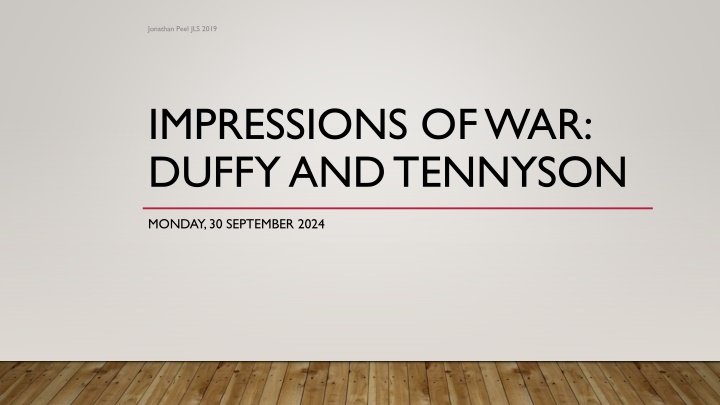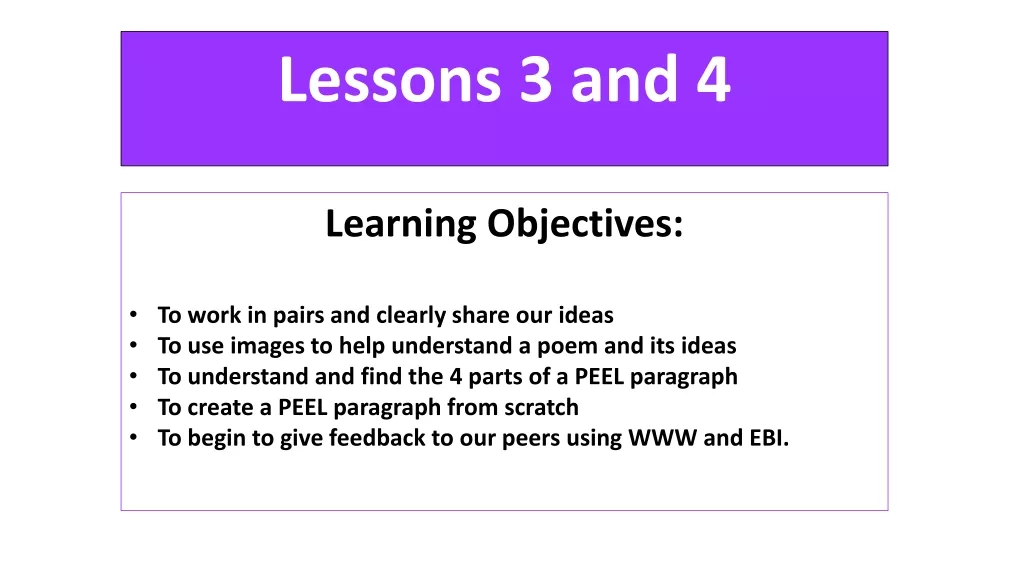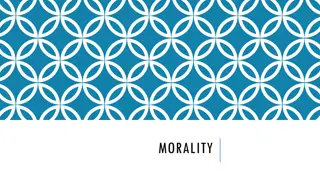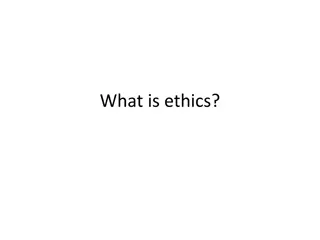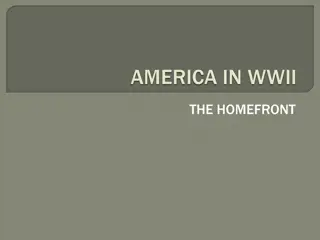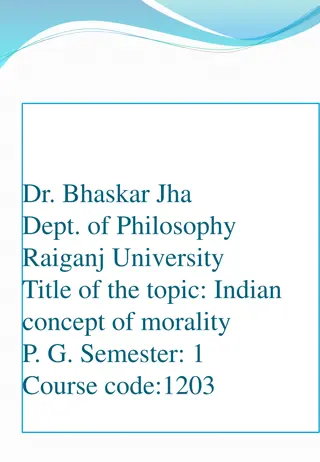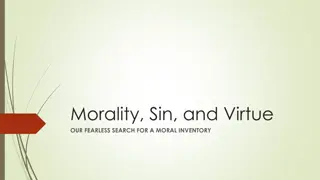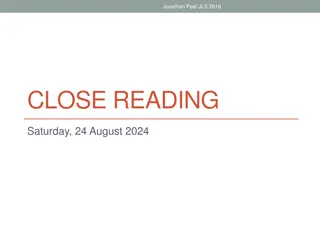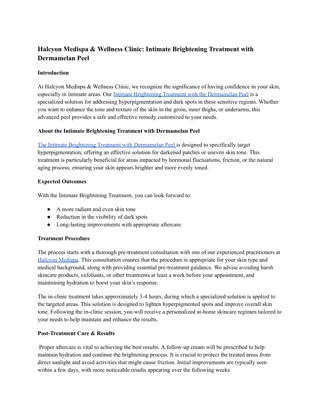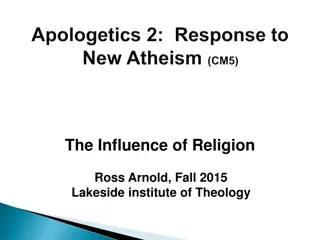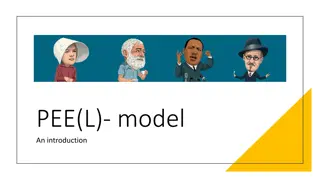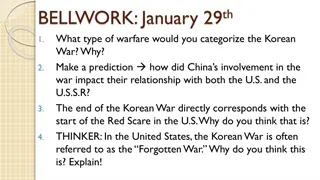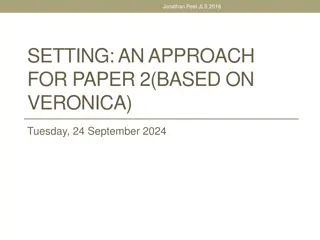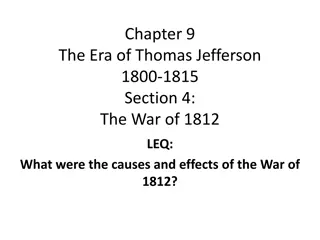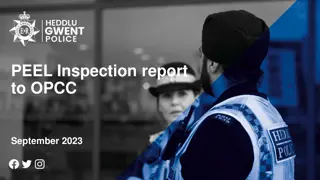Jonathan Peel JLS 2019 Exploration of War and Morality
Jonathan Peel in JLS 2019 delves into the impressions of war, drawing parallels between the works of poets like Duffy and Tennyson. His analysis covers themes of moral imperative, religion, and the personal trials faced by individuals dealing with the aftermath of conflict. Peel's examination highlights the complexity of war photography and the deep emotional impact it leaves on those exposed to its horrors.
Uploaded on Sep 30, 2024 | 0 Views
Download Presentation

Please find below an Image/Link to download the presentation.
The content on the website is provided AS IS for your information and personal use only. It may not be sold, licensed, or shared on other websites without obtaining consent from the author.If you encounter any issues during the download, it is possible that the publisher has removed the file from their server.
You are allowed to download the files provided on this website for personal or commercial use, subject to the condition that they are used lawfully. All files are the property of their respective owners.
The content on the website is provided AS IS for your information and personal use only. It may not be sold, licensed, or shared on other websites without obtaining consent from the author.
E N D
Presentation Transcript
Jonathan Peel JLS 2019 IMPRESSIONS OF WAR: DUFFY AND TENNYSON MONDAY, 30 SEPTEMBER 2024
Jonathan Peel JLS 2019 CONSIDER THIS STATEMENT FROM GEORGE ALAGIAH (FROM A PASSAGE TO AFRICA, EDEXCEL IGCSE ANTHOLOGY.)
Jonathan Peel JLS 2019 OVERVIEW 4 stanzas, each covering a stage in the process of development to print Iambic Pentameter suggests the importance of the material Almost heroic couplets not wholly rhyming couplet structure. Such organisation is reminiscent of a hymn or work of high poetic form. It also suggests clarity of thought and we need to notice the variations as important when they come. Anonymous and therefore applicable to all people and all times.
Jonathan Peel JLS 2019 WAR PHOTOGRAPHER Many of the same ideas as Alagiah: We note the links in terms of the ideas of the horror and the influence of the editor in choosing only the most shocking images, but we focus on the word MUST the moral imperative which this poem explores.
Jonathan Peel JLS 2019 RELIGION AND THE MORAL IMPERATIVE Imagery throughout the first two stanzas which links the photographer to a priest. The idea of having someone to bear witness is evident The sacred duty to tell the truth in the face of hardship The sense of working in a role as a righteous being The sense of a vocation is implied
The metaphor is complex the spools are indeed now the carriers of suffering, the ordered rows possibly suggesting the war graves seen in memorials Jonathan Peel JLS 2019 Technical requirement in a darkroom which echoes the candles glowing in front of an altar (softly) The simile confirms the idea of the religious nature of the job and thus the sense of vocation Solemnity. The cities take on the sound of a religious service, ending with the funeral text. A job - a vocation Developing fluid takes on the overtone of Communion wine in the context of the previous stanza
Jonathan Peel JLS 2019 A PERSONAL TRIAL Is suffering from some form of PTSD Unable to remove self from the effects of what has been seen Flashbacks Recalls images familiar to the reader Tropes of war poetry from an earlier age
Does the broken line and short statement explain or contain a sense of contempt? The rather out of control enjambment is brought up sharp by the double caesura reality. Jonathan Peel JLS 2019 Only now is suffering, once home The sense of a ghost ties in with Alagiah s ghoulish manner neither dead nor alive, kept alive by his photograph- twist suggests the physical pain in the picture The enjambment again seems to suggest a lack of control over the reappearance of the images. Sound imagery highlights the lack of direct communication The moral imperative: to bear witness to suffering and cruelty
Jonathan Peel JLS 2019 THE TROPE OF BLOOD ON LAND Either: Brooke s self-obsessed jingoism or Hardy s wider conciliatory world view. The photographer and the victim are utterly anonymous and any sense of identification is avoided, making the poem applicable to all
Jonathan Peel JLS 2019 THE RESPONSE As the poem s stanzas outline the process by which the photographs are developed and become objects in their own right, causing the emotional response of the photographer, so in the last stanza we read of the response from the three stakeholders the editor, the reader and the photographer. The final line picks up the mood of the earlier lines he has a job to do , and what someone must
The Spools of suffering are now metaphorical agonies , as though each picture presented an archetype for both victim and photographer Jonathan Peel JLS 2019 A sharp pain but a short one the enjambment intrigues as we hurry to follow the thought process almost like the momentary interruption of the day by the prick itself. Newsprint and clarity of message. A loss of control over the process. A sense of a higher authority The internal rhyme reinforces the triteness of the response
Jonathan Peel JLS 2019 THE LAST COUPLET He is already airborne he has a job to do and has no part in the process of delivery He stares impassively he has removed himself from reality and rural England and his emotions have shut down again It is a job he earns his living a coping mechanism They do not care is he bitter? There is a coldness in this line and a lack of emotion certainly critical of the public receiving the material, but also of the Editors. What of the sufferers are they also included in this comment?
Jonathan Peel JLS 2019 IN AN EARLIER TIME Little or no news pictures in 1850s. Most were staged and used in material produced well after the event - carefully edited for public consumption. War poetry is changing Southey has explored futility in The Battle of Blenheim . In Light Brigade, Tennyson explores both responsibility and heroism in abject failure a distinct shift from the typical muscular Christian, God is an Englishman poetry so popular in Victorian England. A poem written to be published in the news The Examiner and which he feared "might prove not to be decorous for a poet laureate . It is a verbal film of that great British war trope the gallant defeat. It also criticises authority without naming those at fault.
Jonathan Peel JLS 2019 Half a league, half a league, The music of the dactylic rhythm creates a sense of order and discpline as we see the horses canter towards the guns much in the manner of Holst in music Ordered advance seen in the repetition of short distances Half a league onward, All in the valley of Death The first variation in this line and line 7 the additional syllable to emphasise the metaphor Death Rode the six hundred. The order is clear the voice issuing the order is not. Direct speech gives veracity yet there is none Tennyson is editorialising Forward, the Light Brigade! Charge for the guns! he said. The repetition of The Six Hundred serves to iconify the group and create a legend Into the valley of Death Rode the six hundred.
Jonathan Peel JLS 2019 RELIGION AS A TROPE Valley of Death is an allusion to Psalm 23 The Valley of Death (Hell) is a test for the Christian Soul who will fear no ill and will trust his God to preserve him. For most in this poem, the salvation will not happen. The Allusion will change to become the Jaws of Death in subsequent stanzas.
Jonathan Peel JLS 2019 THE CHARGE PICKS UP PACE The rhetorical question establishes a link between bravery and knowledge of poor leadership bravery is to show courage despite knowing the reality of the situation anonymous again: universality More direct speech allows reader to hear the battle Imperatives must be obeyed. Forward, the Light Brigade! Was there a man dismayed? Not though the soldier knew Someone had blundered. Theirs not to make reply, The pace increases as the dactyls are no longer punctuated Theirs not to reason why, Theirs but to do and die. Into the valley of Death Almost as a refrain, the twin ideas of the 600 and death are re-established Rode the six hundred.
Jonathan Peel JLS 2019 THE CANNONADE In Stanza three the rhythm becomes fractured. Whilst the front-loading of the word canons serves to create the idea of the gunshots. I prefer to focus on the idea that the canon shot disrupts the organised rhythm of the charge, carefully established in the opening 2 stanzas. The hard consonants produce the effect of breaking the lines
Jonathan Peel JLS 2019 Alliterative dentals and gutterals break up the charge. The rhythm is unaltered as the riders continue. Sibilants add another layer of sound to the onomatopoieia, whilst the line shave no flow due to the consonants. Cannon to right of them, Cannon to left of them, Cannon in front of them Volleyed and thundered; Stormed at with shot and shell, Boldly they rode and well, Into the jaws of Death, Into the mouth of hell Rode the six hundred. The hendiadys of Boldly they rode and well separates the bravery from the skill. The rhythm remains unbroken The imagery redoubles the jaws of death act to personify the valley as a huge monster. The mouth of Hell leaves nothing unspoken fire, brimstone and certain death.
Jonathan Peel JLS 2019 THE TURNING POINT IS REACHED Stanzas lengthen to this point as though echoing the distance from safety for the cavalrymen After the cannonade, the focus shifts to the cavalry themselves and onomatopoieia is again used to add a layer of vividness to the description of the battle. Tennyson introduces the horror of the retreat in the last couplet.
Jonathan Peel JLS 2019 SOUND AND FURY . SIGNIFYING? Repetition and onomatopoieia combine to produce vivid sound and visual imagery. Alliteration accents the description of the destroyed Russian forces 2 key words: army and wondered . Size matters: the 600 now charge an army untrue but successful journalese to stress the impossible odds. All the world (really?) wondered suggests awe but also a questioning of the act itself. What is the role of the war poet here? Flashed all their sabres bare Flashed as they turned in air Sabring the gunners there, Charging an army, while All the world wondered. Plunged in the battery-smoke Right through the line they broke; Cossack and Russian Reeled from the sabre stroke Shattered and sundered. Then they rode back, but not Not the six hundred The double negative, split across 2 lines serves to emphasise the loss. Tennyson has established the 600 as a unit in this poem now we reach the truth the loss. The focus shifts dramatically to the aftermath at this point. .
Jonathan Peel JLS 2019 THE RETURN Emotive placement of key words: horse and hero establishes the idea of heroic death in a lost cause Cannon to right of them, Cannon to left of them, Cannon behind them Volleyed and thundered; Stormed at with shot and shell, While horse and hero fell. They that had fought so well Came through the jaws of Death, Back from the mouth of hell, All that was left of them, Left of six hundred. The pattern is identical to Stanza 3 -note behind them. This is a factual description of the event. The beginning of the moral imperative on the reader which will be confirmed in the last stanza: they that had fought so well All that was left of them Re-emphasises the idea of the 600 as a poetic, heroic whole.
Jonathan Peel JLS 2019 THE JOURNALISTIC IMPERATIVE Duffy focused on the moral imperative to bear witness, Tennyson does this and draws focus to the moral imperative to honour the light brigade . This is in line with modern charities such as Help For Heroes and the development of the Remembrance Celebrations which emerged as a nation came to terms with the losses of the First World War.
Jonathan Peel JLS 2019 Addressing his readers, Tennyson asks the rhetorical question, fully expecting the answer: never . He has set this up over the 5 preceding stanzas wild is interesting Tennyson opts to celebrate the romantic nature of the charge rather than to overload the idea of heroism again. When can their glory fade? O the wild charge they made! All the world wondered. In the repetition of the line all the world wondered I believe the focus is clearly on awe at this stage. Honour the charge they made! Honour the Light Brigade, The double imperative honour underlines the moral imperative on the reader and also on the journalist to honour and respect the bravery of those involved, whilst not losing sight of the blunders highlighted earlier. Noble six hundred! noble moves the 600 to a level beyond brave and to a new social stratum the officers who blundered were noble perhaps the 600 are more deserving of the title?
Jonathan Peel JLS 2019 IN SUMMARY 2 poems which explore the role of the war correspondent. Duffy focuses on the journalist and the response of a disinterested public. Often overloaded with graphic imagery form a war zone the public lose interest they do not care . Tennyson, possibly for the first time uses his position as poet laureate to not only describe the event in graphic detail- each stanza a spool of suffering , but also to impose the moral imperative on the readership the need to honour and value the blood spilled in their name. Both poems have a note of criticism of authority and of the mechanism of reporting.
